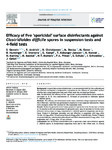2022-01-22Zeitschriftenartikel
Efficacy of five ‘sporicidal’ surface disinfectants against Clostridioides difficile spores in suspension tests and 4-field tests
Gemein, S.
Andrich, R.
Christiansen, B.
Decius, M.
Exner, M.
Hunsinger, B.
Imenova, E.
Kampf, G.
Koburger-Janssen, T.
Konrat, K.
Martiny, H.
Meckel, M.
Mutters, N.T.
Pitten, F-A.
Schulz, S.
Schwebke, I.
Gebel, J.
Background:
A sporicidal surface disinfection is recommended both for the outbreak and the endemic setting but a comparative evaluation on the efficacy of ‘sporicidal’ surface disinfectants using suspension tests and 4-field tests has not been performed.
Aim:
To determine the efficacy of five ‘sporicidal’ surface disinfectants (three ready-to-use wipes (A, B, E), two concentrates (C, D) based on peroxides or aldehydes against C. difficile spores.
Methods:
The efficacy was determined under clean conditions using a suspension test and the 4-field test. Each test was performed in duplicate in two separate laboratories. Wipes were wrung to collect the solution for the suspension tests.
Results:
Product A (peracetic acid; 5 min), product C (peracetic acid; 2% solution in 15 min or 1% solution in 30 min) and product D (peracetic acid; only 2% solution in 15 min) were effective with at least a 4 log10-reduction of C. difficile spores in suspension and on surfaces. Product B (hydrogen peroxide) was not effective in suspension (0.9 log10 after 15 min; 3.2 log10 after 1 h) and on surfaces (2.8 log10 after 15 and 60 min). Product E based on glutaraldehyde, (ethylendioxy)dimethanol and DDAC demonstrated 0.9 log10 after 4 h in suspension and 4.5 log10 after 4 h on surfaces.
Conclusions:
Not all surface disinfectants with a sporicidal claim were effective against C. difficile spores in standardized suspension tests and in the 4-field test. In clinical practice preference should be given to products that reliably pass the efficacy criteria of both types of tests.
Files in this item

